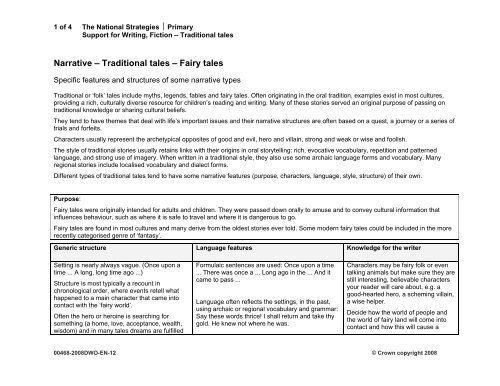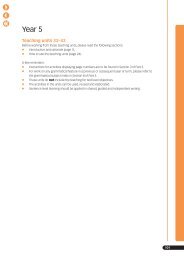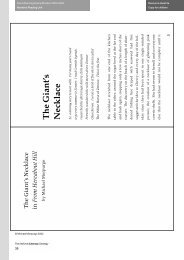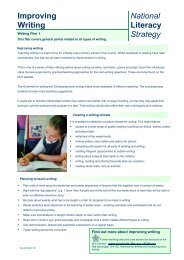Narrative – Traditional tales – Fairy tales
Narrative - Traditional tales - Fairy tales - School-Portal.co.uk
Narrative - Traditional tales - Fairy tales - School-Portal.co.uk
- No tags were found...
Create successful ePaper yourself
Turn your PDF publications into a flip-book with our unique Google optimized e-Paper software.
1 of 4 The National Strategies ⏐ PrimarySupport for Writing, Fiction <strong>–</strong> <strong>Traditional</strong> <strong>tales</strong><strong>Narrative</strong> <strong>–</strong> <strong>Traditional</strong> <strong>tales</strong> <strong>–</strong> <strong>Fairy</strong> <strong>tales</strong>Specific features and structures of some narrative types<strong>Traditional</strong> or ‘folk’ <strong>tales</strong> include myths, legends, fables and fairy <strong>tales</strong>. Often originating in the oral tradition, examples exist in most cultures,providing a rich, culturally diverse resource for children’s reading and writing. Many of these stories served an original purpose of passing ontraditional knowledge or sharing cultural beliefs.They tend to have themes that deal with life’s important issues and their narrative structures are often based on a quest, a journey or a series oftrials and forfeits.Characters usually represent the archetypical opposites of good and evil, hero and villain, strong and weak or wise and foolish.The style of traditional stories usually retains links with their origins in oral storytelling: rich, evocative vocabulary, repetition and patternedlanguage, and strong use of imagery. When written in a traditional style, they also use some archaic language forms and vocabulary. Manyregional stories include localised vocabulary and dialect forms.Different types of traditional <strong>tales</strong> tend to have some narrative features (purpose, characters, language, style, structure) of their own.Purpose:<strong>Fairy</strong> <strong>tales</strong> were originally intended for adults and children. They were passed down orally to amuse and to convey cultural information thatinfluences behaviour, such as where it is safe to travel and where it is dangerous to go.<strong>Fairy</strong> <strong>tales</strong> are found in most cultures and many derive from the oldest stories ever told. Some modern fairy <strong>tales</strong> could be included in the morerecently categorised genre of ‘fantasy’.Generic structure Language features Knowledge for the writerSetting is nearly always vague. (Once upon atime ... A long, long time ago ...)Structure is most typically a recount inchronological order, where events retell whathappened to a main character that came intocontact with the ‘fairy world’.Often the hero or heroine is searching forsomething (a home, love, acceptance, wealth,wisdom) and in many <strong>tales</strong> dreams are fulfilledFormulaic sentences are used: Once upon a time... There was once a ... Long ago in the ... And itcame to pass ...Language often reflects the settings, in the past,using archaic or regional vocabulary and grammar:Say these words thrice! I shall return and take thygold. He knew not where he was.Characters may be fairy folk or eventalking animals but make sure they arestill interesting, believable charactersyour reader will care about, e.g. agood-hearted hero, a scheming villain,a wise helper.Decide how the world of people andthe world of fairy land will come intocontact and how this will cause a00468-2008DWO-EN-12 © Crown copyright 2008
2 of 4 The National Strategies ⏐ PrimarySupport for Writing, Fiction <strong>–</strong> <strong>Traditional</strong> <strong>tales</strong>with a little help from magic. ‘<strong>Fairy</strong> tale endings’(where everything turns out for the best) arecommon but many fairy <strong>tales</strong> are darker andhave a sad ending.problem.Use numbers and patterns that usuallyappear in fairy <strong>tales</strong>:the numbers 3 and 7.Use phrases that have a strong rhymeor rhythm or another kind of pattern: amagic sentence is repeated severaltimes during the story, the hero mustsay a secret rhyme to escape, a line isused at the beginning of each sectionor chapter. (On and on walked thelittle old man.)Use different styles of language for thehuman beings and the characters fromthe fairy world when they speak, tomake a strong contrast between them:“Eeeek! Who are you, you wrinkly oldthing?” asked Tom.“Beware, child and address me withrespect. I am not of your world,” camethe goblin’s whispered reply.Specific features of fairy <strong>tales</strong>Origin, audience and purposeThe oldest forms of fairy <strong>tales</strong> were originally intended for adults and children. These early folk <strong>tales</strong> were passed down orally from generation to generation andlater became increasingly associated with children as their audience. Their primary purposes are to amuse and to convey cultural information that influencesbehaviour (mountains can be dangerous places to travel alone, unselfish behaviour benefits the community and is rewarded, do as your parents tell you and allwill be well).00468-2008DWO-EN-12 © Crown copyright 2008
3 of 4 The National Strategies ⏐ PrimarySupport for Writing, Fiction <strong>–</strong> <strong>Traditional</strong> <strong>tales</strong>Later adaptations, written in a more literary and sophisticated style, are also among the traditional stories known as fairy <strong>tales</strong> although the often gory andfrightening content of the original stories was sometimes sanitised by those who composed new, written adaptations. <strong>Fairy</strong> <strong>tales</strong> are found in most cultures andmany derive from the oldest stories ever told. New fairy <strong>tales</strong> are still being written today although some of these texts with fairy-tale elements (such as TheHobbit) could be included in the more recently categorised genre of fantasy.ThemeThe familiar themes of many traditional stories are prevalent in fairy <strong>tales</strong>:• magic and skill;• safe and dangerous;• good and evil;• weak and strong;• rich and poor;• wise and foolish;• old and young;• beautiful and ugly;• mean and generous;• just and unjust;• friend and foe;• family/home and stranger/far away;• the origins of the Earth, its people and animals;• the relationship between people and the seen or unseen world around them.Character<strong>Fairy</strong> <strong>tales</strong> consistently include some of the most familiar and traditional archetypes of all folk <strong>tales</strong> (hero, villain, mentor, trickster, sage, shape shifter, herald).Human characters are simply the people who lived in the castles, cottages and hovels of the original stories: kings and queens, princes and princesses, knightsand ladies, poor farmers, youngest sons, wise old women, beggars, tailors, soldier, a goose-girl. The main character is often humble, melancholy or hardworkingand wants to make life better.Characters also include a wide range of magical folk including animals or creatures who may have mystical powers yet behave with human characteristics. Thenames given to the inhabitants of the fairy world vary in different cultures but they include the ‘little folk’ (elves, imps, fairies, leprechauns, pixies/piskies, goblinsand dwarfs) as well as the larger and often more sinister trolls, giants, ogres, wizards and witches.Interestingly, the presence of fairies or talking animals is not necessarily the best way to identify a traditional tale as a fairy story. Many fairy stories do notinclude fairies as characters and the main characters in fables are often talking animals.00468-2008DWO-EN-12 © Crown copyright 2008
4 of 4 The National Strategies ⏐ PrimarySupport for Writing, Fiction <strong>–</strong> <strong>Traditional</strong> <strong>tales</strong>Plot and structureThe setting and details about when events took place are nearly always vague. (Once upon a time ... A long, long time ago ... It happened that ... Once therewas a small cottage in the middle of a forest ...)The stories tell the adventures of people in the land of fairy folk so plots usually include the use of magic, fantastic forces and fanciful creatures. Sometimes theinhabitants of the magical land of ‘faerie’ venture into the world of humans and this disruption of the status quo triggers a far-fetched sequence of events.Enchantments are common and rule-breaking has consequences.Often the hero or heroine is searching for something (a home, love, acceptance, wealth, wisdom) and in many <strong>tales</strong> dreams are fulfilled with a little help frommagic. ‘<strong>Fairy</strong> tale endings’ (where everything turns out for the best) are common. Heroes overcome their adversaries and girls marry the prince of their dreamsbut many fairy <strong>tales</strong> are darker and have a sad ending. The fairy <strong>tales</strong> of Hans Christian Andersen, for example, include many where things go from bad toworse even for ‘good’ characters or where people’s negative characteristics are their downfall at the end. (The little match girl dies tragically in the snow, thefashion-obsessed emperor becomes a laughing stock when he parades through the city wearing nothing at all, the toy soldier melts away to a lump of lead.)This means that careful selection of texts is required to ensure age-appropriateness.Style<strong>Fairy</strong> <strong>tales</strong> include good examples of the repetitive, rhythmic and patterned language of traditional stories. Phrases or expressions are repeated for emphasis orto create a magical, theatrical effect (so she went over the gate, across the meadow and down to the stream once more ... not once, not twice, but three times...).<strong>Fairy</strong> stories use:• rich, evocative vocabulary;• the language of the fairy world (magic spells, incantations, charms);• the spoken language of the ordinary people (dialogue, regional accent and dialect vocabulary, informal expressions);• memorable language (rhyme, alliteration, assonance, repetition);• formulaic openings and endings; imagery: simile, metaphor and symbolism.<strong>Fairy</strong> <strong>tales</strong> are commonly presented as implausible but it is important to remember that in cultures where the inhabitants of the magical world are perceived asreal, the stories may be interpreted more as legends, so that storyteller and reader/audience understand them to have some historical, factual basis.00468-2008DWO-EN-12 © Crown copyright 2008








